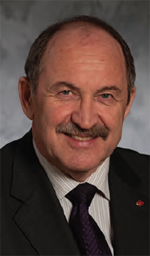 Dr. Ronald G. Smith
Dr. Ronald G. Smith
This special edition of JCDA features the latest developments at the University of British Columbia faculty of dentistry, the dental school in my home province. This sparked my thoughts on how dental education has changed over the years, and how it will continue to evolve as advances in oral health research and the integration of modern technologies within the learning process take hold.
In fact, it brought to mind an audio interview I heard a few years ago between Dr. Richard Valachovic, executive director of the American Dental Education Association, and Dr. John O'Keefe, JCDA editor-in-chief (www.cda-adc.ca/editor/valachovic.html). In a discussion on the future of dental education, Dr. Valachovic was asked to speculate on what macro-level developments in the sector would have an impact on Canadian dentistry.
He identified the significant challenges faced by all dental schools in trying to keep pace with new scientific breakthroughs in oral health research. He also outlined the difficulty of trying to teach such dynamic areas of study as genomics, imaging and diagnostics within the constraints of a traditional 4-year undergraduate curriculum.
Rather than attempting to cover all new developments within the curriculum, I believe the profession should adopt a philosophy that encourages dental students to embrace the concept of continuous learning and competency. For example, we could make greater efforts to ensure that graduating dentists are prepared to learn, throughout the course of their career, the skills that will be required to treat the complex oral health needs of the frail elderly, as this population segment will continue to increase.
Another issue identified by Dr. Valachovic was the aging of dental faculty members combined with a scarcity of younger professors to fill these roles when retirements inevitably occur. According to his estimates, nearly half of all dental faculty members in North America are set to retire in the coming decade. Dental schools will likely need to reach out to practising dentists to fill some of these clinical teaching roles. It will be crucial for the Canadian academic community and practising dentists to come together with greater frequency. While some general dentists might perceive a disconnect between dentists in the field and their colleagues in academia, we have mutual needs and we can all make the profession stronger if we function as a united dental community.
Another topic discussed by Dr. Valachovic was the impact of technology on the learning process. The ability of dental students to access clinical information and other resources at the click of a mouse is changing the way dental school is structured. No longer does learning have to take place in a traditional lecture hall at set times. Students learning in small groups, and often at their own pace, is quickly becoming the norm. The physical layout of dental schools is also evolving as clinical learning activities are being shifted from university-based clinics to community- or hospital-based clinics.
The potential shortage of dental faculty and the integration of technology in the curriculum can actually result in educational innovation. Dental schools are beginning to explore ways of sharing the expertise of their professors through the use of streaming video and virtual learning capabilities. For example, at the Nobel Biocare Oral Health Centre at UBC, a professor in Vancouver can now simultaneously broadcast a clinical demonstration to dental students located in the province, across Canada or on the other side of the globe.
The impact of such technologies mirrors the evolution of JCDA as it continues to explore partnerships with universities and publishers, to organize and present useful clinical information for dentists in new formats.
There is no doubt that the dental learning environment is changing at a rapid pace. As some of the traditional walls come down—whether in our lecture halls or between practising dentists and academia—and as we embrace the concept of continuous learning, we can all come together to ensure a thriving Canadian dental profession for the future.
